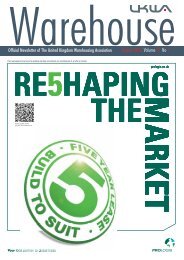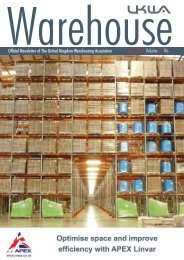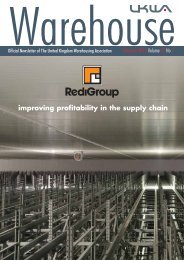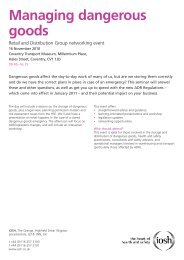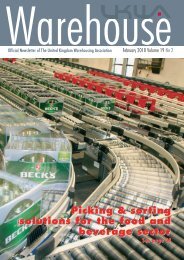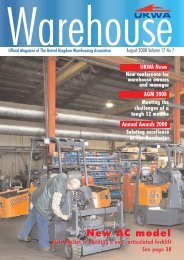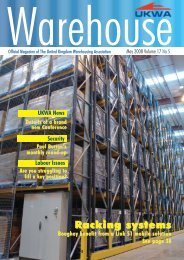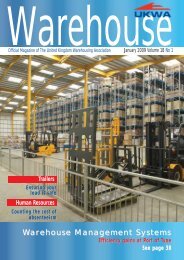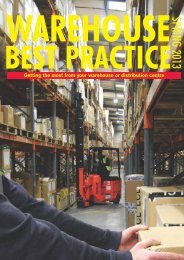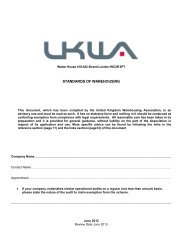ifwla - Warehousing and Logistics International
ifwla - Warehousing and Logistics International
ifwla - Warehousing and Logistics International
- No tags were found...
Create successful ePaper yourself
Turn your PDF publications into a flip-book with our unique Google optimized e-Paper software.
26 AutomationWarehouse automation frequently fails to live up to expectations. However, Andrew Robinson ofUnipart Expert Practices (UEP) argues this should never arise if the correct approach is taken <strong>and</strong> a strictmethodology applied - one that takes an ‘end-to-end’ view of the supply chain.How to ensurepayback onautomationImplementing an automated warehouse is acomplex, expensive <strong>and</strong> sometimes risky venture.According to a recent survey conductedby Cranfield University into 27 warehouseautomation projects, ‘there are real concernsabout disruption to the ongoing operation inthe short-term <strong>and</strong> the degree of future flexibilityin the longer-term’ (1)An investment in automation - whether it is a storage<strong>and</strong> retrieval system, sortation project, order forwardingprocess or, for that matter, any other activity - may notnecessarily slash costs, eliminate bottlenecks or boostcapacity in the ways expected. Indeed, quite the oppositecan happen.The resultant soul searching <strong>and</strong> identification of asuitable scapegoat is a painful process for all. So, arethere some general rules on how this can all be avoided?Can you make sure your automation project paysbackin an acceptable timescale <strong>and</strong> delivers what youexpect?The first question to ask - <strong>and</strong> the one most frequentlyforgotten - is ‘do I really need to automate theprocess?’ Baker <strong>and</strong> Halim (1) cite three key motivatingfactors for implementing automation:• To accommodate growth• To reduce operating costs• To improve customer serviceHowever, none of these reasons necessarily requirean automated solution. Significantimprovements in all three can frequently be achievedby redesigning existing business processes.For a given, repeatable, task applying automationcan typically achieve higher levels of productivity than amanual solution. It is this productivity gain that normallysits at the heart of any justification for a piece of automatedequipment. The constraints of a manual process- be it the speed of people, space needed to completethe work, presentation of material to the operative, orremoval of work-in-progress - means the manualprocess usually has a finite capacity. By adding a levelof automation the intention is to remove that constraint;either fewer things happen or those things that happendo so faster <strong>and</strong> with greater reliability. However, asBaker <strong>and</strong> Halim point out, this may be at the cost offlexibility in the long term.There are two steps to ensuring payback on anautomation project. The first is to see if an improvementcould be made to the current manual process that alleviatesthe constraint without the need for investment inautomation. The second is to invest in a way thatensures productivity levels go up in the way intended.Let us take each of these steps in turn. Improving manualprocesses As any ‘lean’ practitioner will tell you, alarge proportion of the activity involved in a process isnon value adding. By analysing what happens in theoperation <strong>and</strong> gaining an in-depth underst<strong>and</strong>ing ofwhat needs to be done, as opposed to what actuallyhappens, the elements that are not required can beidentified. Typically these fall into the categories of ‘Theseven wastes’: Transportation, Inventory, Motion,Waiting, Over processing, Over production <strong>and</strong>Defects.These are sometimes remembered by the acronymTIM WOOD (or WOODE if environmental waste isadded).By tackling these wastes in a systematic way, it isusually possible to increase capacity, reduce costs <strong>and</strong>improve flexibility. Making a heavy investment inautomation <strong>and</strong> then simply continuing to do the samewasteful activities but at a faster rate is not money wellissue No 3www.warehousinglogisticsinternational.com




